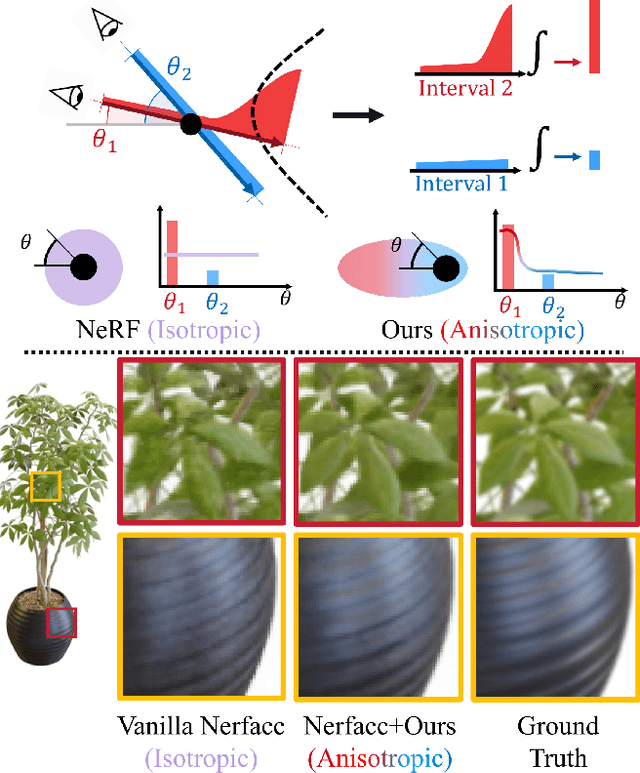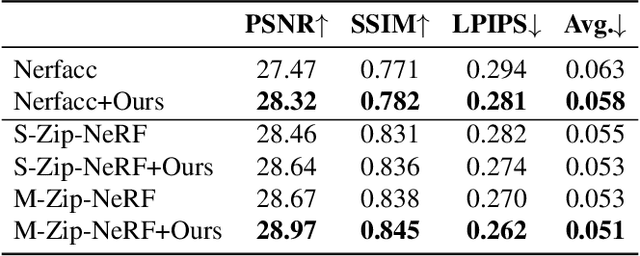Y. Zeng
Stylizing Sparse-View 3D Scenes with Hierarchical Neural Representation
Apr 08, 2024



Abstract:Recently, a surge of 3D style transfer methods has been proposed that leverage the scene reconstruction power of a pre-trained neural radiance field (NeRF). To successfully stylize a scene this way, one must first reconstruct a photo-realistic radiance field from collected images of the scene. However, when only sparse input views are available, pre-trained few-shot NeRFs often suffer from high-frequency artifacts, which are generated as a by-product of high-frequency details for improving reconstruction quality. Is it possible to generate more faithful stylized scenes from sparse inputs by directly optimizing encoding-based scene representation with target style? In this paper, we consider the stylization of sparse-view scenes in terms of disentangling content semantics and style textures. We propose a coarse-to-fine sparse-view scene stylization framework, where a novel hierarchical encoding-based neural representation is designed to generate high-quality stylized scenes directly from implicit scene representations. We also propose a new optimization strategy with content strength annealing to achieve realistic stylization and better content preservation. Extensive experiments demonstrate that our method can achieve high-quality stylization of sparse-view scenes and outperforms fine-tuning-based baselines in terms of stylization quality and efficiency.
Can Channels be Fully Inferred Between Two Antenna Panels?
Feb 08, 2024Abstract:This letter considers a two-panel massive multiple-input multiple-output (MIMO) communication system, where the base station (BS) is equipped with two antenna panels that may use different frequency bands for communication. By exploiting the geometric relationships between antenna panels, efficient channel inference methods across antenna panels are proposed to reduce the overhead of real-time channel estimation. Four scenarios are considered, namely far-field free-space, near-field free-space, multi-path sharing far-field scatterers, and multi-path sharing near-field scatterers. For both far-field and near-field free-space scenarios, we show that the channel of one panel can be fully inferred from that of the other panel, as long as the multi-path components (MPCs) composing the channel can be resolved. On the other hand, for the multi-path scenarios sharing far-field or near-field scatterers, only the angles or range of angles of the MPCs can be inferred, respectively. Simulation results based on commercial 3D ray-tracing software are presented to validate our developed channel inference techniques.
A Novel Geometric Solution for Moving Target Localization through Multistatic Sensing in the ISAC System
Jan 29, 2024Abstract:This paper proposes a novel geometric solution for tracking a moving target through multistatic sensing. In contrast to existing two-step weighted least square (2SWLS) methods which use the bistatic range (BR) and bistatic range rate (BRR) measurements, the proposed method incorporates an additional direction of arrival (DOA) measurement of the target obtained from a communication receiver in an integrated sensing and communication (ISAC) system. Unlike the existing 2SWLS methods that require at least three transmitter-receiver (TX-RX) pairs to operate, the proposed algorithm can conduct location estimation with a single TX-RX pair and velocity estimation with two TX-RX pairs. Simulations reveal that the proposed method exhibits superior performance compared to existing 2SWLS methods, particularly when dealing with moderate levels of noise in DOA measurements.
Anisotropic Neural Representation Learning for High-Quality Neural Rendering
Nov 30, 2023



Abstract:Neural radiance fields (NeRFs) have achieved impressive view synthesis results by learning an implicit volumetric representation from multi-view images. To project the implicit representation into an image, NeRF employs volume rendering that approximates the continuous integrals of rays as an accumulation of the colors and densities of the sampled points. Although this approximation enables efficient rendering, it ignores the direction information in point intervals, resulting in ambiguous features and limited reconstruction quality. In this paper, we propose an anisotropic neural representation learning method that utilizes learnable view-dependent features to improve scene representation and reconstruction. We model the volumetric function as spherical harmonic (SH)-guided anisotropic features, parameterized by multilayer perceptrons, facilitating ambiguity elimination while preserving the rendering efficiency. To achieve robust scene reconstruction without anisotropy overfitting, we regularize the energy of the anisotropic features during training. Our method is flexiable and can be plugged into NeRF-based frameworks. Extensive experiments show that the proposed representation can boost the rendering quality of various NeRFs and achieve state-of-the-art rendering performance on both synthetic and real-world scenes.
Relay Assisted Multiuser OWC Systems under Human Blockage
Apr 10, 2023Abstract:This paper proposes using cooperative communication based on optoelectronic (O-E-O) amplify-and-forward relay terminals to reduce the influence of the blockage and shadowing resulting from human movement in a beam steering Optical Wireless Communication (OWC) system. The simulation results indicate that on average, the outage probability of the cooperative communication mode with O-E-O relay terminals is two orders of magnitude lower than the outage probability of the system without relay terminals.
Multiuser beam steering OWC system based on NOMA
Apr 10, 2023Abstract:In this paper, we propose applying Non-Orthogonal Multiple Access (NOMA) technology in a multiuser beam steering OWC system. We study the performance of the NOMA-based multiuser beam steering system in terms of the achievable rate and Bit Error Rate (BER). We investigate the impact of the power allocation factor of NOMA and the number of users in the room. The results show that the power allocation factor is a vital parameter in NOMA-based transmission that affects the performance of the network in terms of data rate and BER.
 Add to Chrome
Add to Chrome Add to Firefox
Add to Firefox Add to Edge
Add to Edge